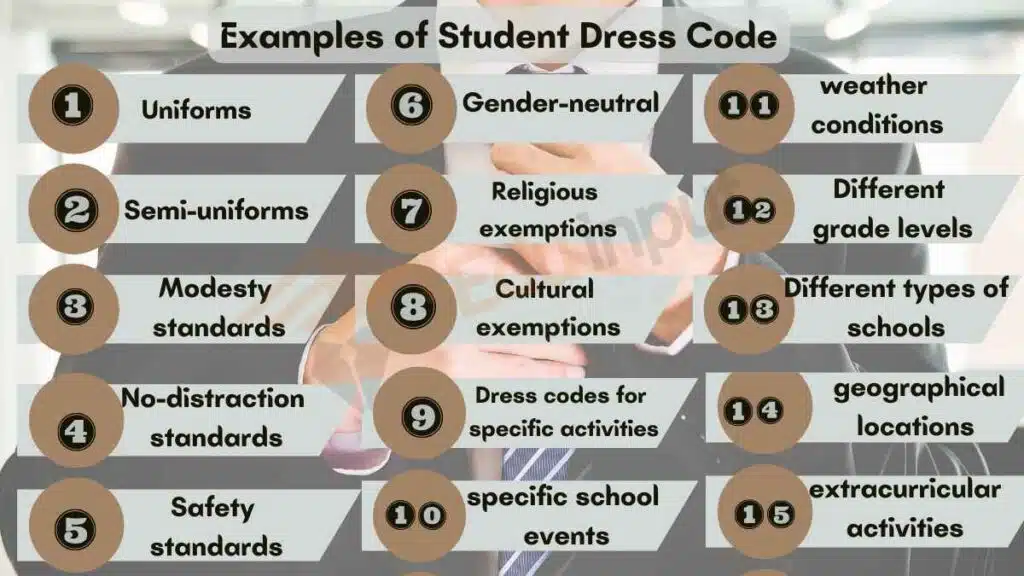15 Examples of Student Dress Code
School dress codes are a controversial topic, with some people arguing that they are necessary to create a safe and focused learning environment, while others believe that they are restrictive and discriminatory.
Regardless of your opinion on dress codes, it is important to be aware of the different types of dress codes that exist and how they vary from school to school.

Examples of Student Dress Code
Here are 15 examples of student dress codes.
1: Uniforms
Uniforms are the most restrictive type of dress code, and they require students to wear a specific type of clothing every day.
Uniforms are often seen as a way to promote school spirit and equality, and they also help to reduce distractions in the classroom.
2: Semi-uniforms
Semi-uniforms are less restrictive than full uniforms, but they still require students to wear certain items of clothing, such as polo shirts or khaki pants.
Semi-uniforms can be a good compromise for schools that want to promote a sense of school spirit without being too restrictive.
3: Modesty standards
Modesty standards are a type of dress code that focuses on the coverage of the body.
Modesty standards vary from school to school, but they typically prohibit students from wearing clothing that is too revealing, such as short skirts, low-cut tops, or tank tops.
4: No-distraction standards
No-distraction standards are a type of dress code that focuses on preventing students from wearing clothing that could be distracting to others.
No-distraction standards can vary from school to school, but they typically prohibit students from wearing clothing with offensive language or images, or clothing that is too revealing.
5: Safety standards
Safety standards are a type of dress code that focuses on preventing students from wearing clothing that could be dangerous.
Safety standards typically prohibit students from wearing clothing that is too baggy, clothing that has drawstrings or cords, or clothing that is made of flammable materials.
6: Gender-neutral dress codes
Gender-neutral dress codes allow students to wear any type of clothing, regardless of their gender.
Gender-neutral dress codes are becoming increasingly popular, as they can help to create a more inclusive and welcoming environment for all students.
7: Religious exemptions
Many schools allow religious exemptions to their dress codes.
This means that students who have religious objections to certain types of clothing can be allowed to wear different clothing, as long as it is still appropriate for a school setting.
8: Cultural exemptions
Some schools also allow cultural exemptions to their dress codes.
This means that students who have cultural objections to certain types of clothing be allowed to wear different clothing, as long as it is still appropriate for a school setting.
9: Dress codes for specific activities
Some schools have dress codes for specific activities, such as physical education classes or field trips.
These dress codes are typically designed to ensure the safety of students.
10: Dress codes for specific school events
Some schools also have dress codes for specific school events, such as proms or dances.
These dress codes are typically designed to create a more formal and special occasion atmosphere.
11: Dress codes for different weather conditions
Some schools have different dress codes for different weather conditions. For example, a school might have a different dress code for winter than it does for summer.
These dress codes are typically designed to ensure the comfort and safety of students.
12: Dress codes for different grade levels
Some schools have different dress codes for different grade levels. For example, a school might have a more lenient dress code for elementary school students than it does for high school students.
These dress codes are typically designed to take into account the different needs and developmental stages of students at different ages.
13: Dress codes for different types of schools
Some schools have different dress codes for different types of schools. For example, a private school might have a more restrictive dress code than a public school.
These dress codes are typically designed to reflect the different values and expectations of different types of schools.
14: Dress codes for different geographical locations
Some schools have different dress codes for different geographical locations. For example, a school in a warm climate might have a more lenient dress code than a school in a cold climate.
These dress codes are typically designed to take into account the different weather conditions in different geographical locations.
15: Dress codes for different extracurricular activities
Some schools have different dress codes for different extracurricular activities. For example, a school might have a different dress code for the school play than it does for the football team.
These dress codes are typically designed to ensure the safety and professionalism of students participating in extracurricular activities.
It is important to note that not all schools have dress codes. Some schools allow students to wear whatever they want to school, as long as it is appropriate for a learning environment.



Leave a Reply